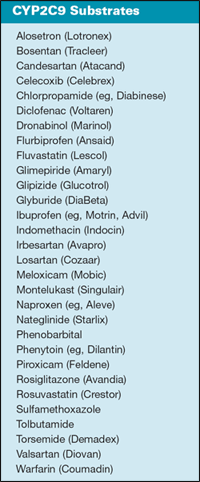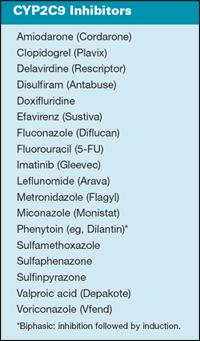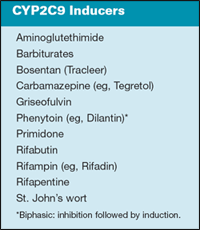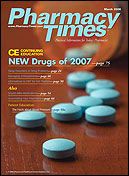Publication
Article
Pharmacy Times
Get to Know an Enzyme: CYP2C9
An in-depth look at CYP2C9, an enzyme involved in many clinically important drug interactions.
Drs. Horn and Hansten are both professorsof pharmacy at the Universityof Washington School of Pharmacy.For an electronic version of this article,including references if any, visitwww.hanstenandhorn.com.
Table

Our column in November 2007(please visit www.PharmacyTimes.com/ EnzymeCYP1A2) discussedthe cytochrome P450 (CYP450) enzymeCYP1A2, which has increased in importancefollowing the release of severaldrugs metabolized by this enzyme. In thisissue, we will discuss an old standby,CYP2C9, an enzyme involved in manyclinically important drug interactions.
CYP450 enzymes, found primarily inthe liver, are involved in the metabolismof most medications; the mostimportant of these enzymes areCYP1A2, CYP2C9, CYP2C19, CYP2D6,and CYP3A4.
CYP2C9 Substrates
Drugs metabolized by CYP2C9 arecalled CYP2C9 substrates. Keep in mindthat many drugs are metabolized bymore than 1 CYP450 enzyme, andCYP2C9 may represent only 1 pathway.CYP2C9 is the primary enzyme responsiblefor metabolizing nonsteroidal antiinflammatorydrugs (NSAIDs), oral antidiabeticagents, and angiotensin II receptorblockers (ARBs). CYP2C9 also is themajor enzyme involved in the dispositionof warfarin.
CYP2C9 Inhibitors
Table

Drugs that inhibit CYP2C9 activity willincrease the plasma concentrations ofcertain medications and, in some cases,adverse outcomes will occur. Any drugthat inhibits CYP2C9, for example, willalmost certainly increase the hypoprothrombinemicresponse to warfarin.Generally, it is preferable to use a noninteractingalternative to the CYP2C9inhibitor; however, if the CYP2C9inhibitor is necessary, appropriate monitoringof the international normalizedratio and warfarin dosage adjustmentsusually can prevent adverse outcomes.
Note that phenytoin is a CYP2C9 substrate,inhibitor, and inducer. Clinically,however, adverse outcomes primarilyhave been due to phenytoin's susceptibilityto toxicity when combined withCYP2C9 inhibitors and its ability to act asan inducer of CYP2C9 and other CYP450enzymes, thus reducing the effect ofmany other medications.
CYP2C9 Inducers
Table

Some drugs induce CYP2C9, and theymay reduce the efficacy of CYP2C9 substrates.Such interactions tend to beinsidious, because they result in lack ofefficacy, rather than more apparentadverse effects. One of the dangers isthat, not knowing that an interaction isoccurring, the dose of the CYP2C9 substrateis increased to compensate for theCYP2C9 induction, and then the CYP2C9inducer is discontinued. This sequence ofevents can result in a substantialincrease in the plasma concentrations ofthe CYP2C9 substrate, leading to toxicity.
Drug Interactions with CYP2C9
Warfarin continues to be a seriousconcern with regard to CYP2C9 druginteractions. Many cases of phenytointoxicity due to concurrent therapy withCYP2C9 inhibitors have been reported,although such reports have beendecreasing, at least in part becausefewer patients are on chronic phenytointherapy.
Also of concern are oral hypoglycemicdrugs. As with warfarin, the effect ofCYP2C9 inhibitors or inducers can becompensated for with dosage adjustmentsof the CYP2C9 substrate. If theCYP2C9 substrate dose has beenincreased to compensate for a CYP2C9inducer, however, stopping the inducercan result in severe hypoglycemia.
For other CYP2C9 substrates, such asNSAIDs or ARBs, adverse consequencesfrom concurrent administration ofCYP2C9 inhibitors or inducers have notbeen widely reported. Nonetheless, oneshould still be alert for evidence of possibleadverse drug interactions.
CYP2C9 Activity in Patients
Genetic variation in CYP2C9 activityhas been described, with some peoplehaving greater-than-normal activity andothers having decreased activity.
Pharmacogenetic testing for CYP2C9may be indicated for some patients toachieve optimal dosing and to predictthe likely outcome of drug interactions.Investigations are under way to determineif genetic testing for CYP2C9 is usefulprior to warfarin therapy in order tobetter select initial dosing.
Summary
CYP2C9 is involved in many drug interactions.Some of the substrates that warrantparticular attention are warfarin,phenytoin, and oral hypoglycemics.Some of the more potent CYP2C9inhibitors include amiodarone, fluorouracil,metronidazole, miconazole(especially systemic use), and sulfamethoxazole(usually combined withtrimethoprim). All of the usual enzymeinducers, such as barbiturates, carbamazepine,and rifampin, can substantiallyincrease CYP2C9 activity.







